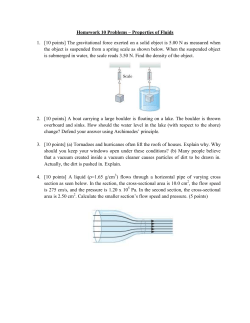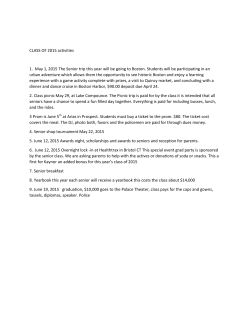
Down the Pipes
Down the Pipes Lisa Bina Photo taken by Rebecca Pierik 23 Environmental Engineering Before I got my current job, I worked as a Peace Corps volunteer trying to solve a very serious problem in a small fishing village in Thailand. The hospital had been flushing untreated sewage directly into a local canal. It polluted the canal terribly and threatened to seep into the drinking water, which Key Concepts from Previous Chapters 15 Differences Drive Change 17 Fluids 17 Pressure at Depth 18 Resistance would have had devastating effects on the community’s health. I helped to design a sewerage system to collect wastewater from the region’s hospital buildings. I also helped the hospital staff construct a treatment facility that treated wastewater before it entered the open canal. While the waste treatment system was Copyright © 2008 Museum of Science, Boston relatively simple, the steps we followed—screening out the solids then chemically treating both the solids and the remaining liquid for safe disposal—are the same complex steps we follow to treat wastewater here in the United States. 209 Courtesy of MWRA Courtesy of MWRA Deer Island Waste Treatment Facilities During large storms, a Combined Sewage Overflow pipe discharges untreated sewage and storm water. Whether you live in Thailand or the United States, waste fluids play a critical role in your community’s health, as well as the health of the natural environment. My name is Lisa Bina, and today I am an engineer with the Massachusetts Water Resources Authority (MWRA). The MWRA ensures that when residents in the Greater Boston area turn on their faucets, clean water comes rushing out. The MWRA also makes sure that every time a Bostonarea resident flushes a toilet, the wastewater flows for miles underground to the Deer Island Treatment Facility in Boston Harbor and finally to a large underwater tunnel to be discharged nearly ten miles out to sea. I create and run computer models that predict whether we have designed our sewers and water lines correctly. My work in Thailand had a strong influence on my career and my commitment to my work as an environmental engineer. At the MWRA, I’m working on a similar problem. You see, the sewer system in Greater Boston was developed over hundreds of years, and parts of it are very old. Many younger cities have systems that handle rainwater and wastewater separately, but around the Boston area, this is not the case. Rainwater flows into street drains and mixes with the wastewater flowing to the Deer Island treatment facility. During major storms, the volume of water becomes too great for the pipes to carry and waste fluid backs up. In the past, to prevent the wastewater from backing up into homes, engineers built overflow points, called Combined Sewage Overflows, or CSOs, which allow the sewage and rainwater to exit the system. Unfortunately, many of these CSOs send untreated overflow into the Boston Harbor, the Charles River, and other bodies of water. Just as it was in Thailand, it’s a major problem to have untreated sewage flowing into these bodies of water—a problem that the MWRA set out to solve almost twenty years ago. Copyright © 2008 Museum of Science, Boston 210 Engineering the Future: Science, Technology, and the Design Process Falling Water Before I tell you how we’re solving this problem, let me explain how our system works. Most water delivered to the taps and toilets of the Boston area is collected in the Quabbin Reservoir in Western Massachusetts. A reservoir is a natural or human-made body of water that collects and stores water for a region. Construction on the Quabbin Reservoir began in 1936. It can hold over 400 billion gallons of water when full. The Quabbin area was chosen in large part because the reservoir is about 525 feet above sea level. Because Boston is at sea level, the Quabbin is also 525 feet above Boston. This difference meant that the water would flow downhill through aqueducts—large pipes used for transporting water long distances—to Boston, driven by gravity. Pumps wouldn’t be needed. What causes water to flow downhill? If you’re familiar with the effects of gravity, you know that if you hold a rock a few feet off of the ground, then let go, it will fall to the ground. But how do you explain a rock falling or water flowing downhill in terms of energy? When you raise the rock, you are doing work on the rock. The energy you are using to do work on the rock is stored in the gravitational field between the rock and the Earth (this is also called potential energy). When you let go, the energy in the gravitational field is transferred to the moving rock as it falls to the ground. Again, difference drives the energy transfer. In this case, the difference is a difference in height. 525 ft. Elevation Chart 0 ft. On this map and corresponding elevation chart, you can see how water drops all the way to Boston. Copyright © 2008 Museum of Science, Boston Difference in height causes a pressure difference and this causes fluid flow. In this case, it’s a difference in height that drives change. UNIT 3 Going with the Flow 211 Greater pressure Hydrostatic Pressure is the pressure exerted on a portion of fluid as a result of the weight of the fluid above it. The difference in the height of the water translates to a difference in pressure. The pressure, called hydrostatic pressure, is the result of the weight of the water pushing down on the water below it in the pipes. You can better understand hydrostatic pressure by considering a diver’s movement through a swimming pool. The force on the diver’s head is equal to the weight of the vertical column of water through which the diver moves. As the diver swims deeper, the column of water against his head grows larger and therefore heavier. As the force of the water increases, the pressure also increases. At the very bottom of the pool, the diver’s head experiences the greatest pressure. Think of the fluid in the aqueducts of the MWRA water system like the fluid in the vertical column of water in the swimming pool. There is a difference between the pressure of the fluid at the top of the aqueduct—at elevation of 525 feet—and the pressure in an aqueduct when it reaches Boston—at sea level. Hydrostatic Pressure, ∆P, can be calculated using Pascal’s Equation: where: t is the density of the liquid and g is the force due to gravity. Because p and g are constants, we can use the following equation to approximate: where: h1 and h2 are expressed in feet The height difference between the reservoir and Boston creates enough ∆P to push water through the taps of many of the city’s buildings—even the taller ones. But Boston’s tallest structures require pumps to push the water to the top floors. Pascal’s equation explains why pumps are necessary. A municipality typically requires water pressure in pipes providing water to residences to measure between 50 and 60 PSI. This amount of pressure is required by most appliances that use water—toilets, taps, dishwashers, and laundry machines. Copyright © 2008 Museum of Science, Boston 212 Engineering the Future: Science, Technology, and the Design Process Using Pascal’s Equation you can determine the pressure of the water at sea level, when h2 is the elevation of the Quabbin Reservoir, and h1 is the elevation at sea level: So the pressure in the pipes at sea level is about 226 PSI. What is the pressure in the pipes on the top floor of a thirty-story building (assuming each story is fifteen feet tall)? Copyright © 2008 Museum of Science, Boston That’s not enough pressure! You can see why this building needs a pump to maintain the minimum water pressure required by household appliances. UNIT 3 Going with the Flow 213 Resistance is opposition to movement. There is less resistance in the larger pipe so it is easier for fluid to flow through it. Going with the Flow When a drop of rain falls into the Quabbin Reservoir, it will take as long as four years for the drop to circulate through the reservoir and find its way to a thirteen-foot-diameter aqueduct. Why do we use a large pipe to transport water long distances? That’s because fluid moving through pipes encounters resistance. Resistance is opposition to movement. The fluid experiences the most resistance where it comes in contact with the pipe’s inner wall. In smaller pipes, more fluid is exposed to the pipe’s inner wall; therefore, the fluid experiences more resistance. Water moving through a pipe is not unlike air blowing through a drinking straw. It’s pretty easy to blow through a wide straw. But if you try blowing through a narrow straw, like the kind people use to stir their coffee, you’ll find that you have to blow hard to get any air through the straw. The resistance reduces the flow of the air through the straw and, likewise, the flow of water through the pipes. Because we want to move large amounts of water all the way from the Quabbin to Boston, we use a large pipe in which the resistance is lower. If we used a two-foot-diameter pipe, for instance, instead of a thirteen-footdiameter pipe, not enough water would reach the city. Once inside an aqueduct, our water drop will travel twenty-five miles downstream (thanks to gravity) to the Wachusett Reservoir, where it will slowly move throughout the reservoir for about eight months, on average. Pumps will then draw our droplet into pipes that pass through a chlorination and fluoridation plant, which add chlorine and fluoride to the water. Chlorine cleanses the water of any bacteria; fluoride helps prevent tooth decay. The droplet will then travel downstream toward Boston. Anywhere along this path, some companion droplets may be pulled out for use by local communities. But if our droplet continues, it will flow downhill toward other smaller, covered reservoirs that serve as holding tanks for Boston and the surrounding communities. Gravity is still driving the droplet down toward Boston. But as it approaches residential areas, the water encounters smaller pipes. Water in the large pipe moved slowly under high pressure due to the force of gravity, but the water in these smaller pipes speeds up. This fundamental principle governs the movement of liquid: as the pipe diameter decreases, the velocity of the water increases and pressure decreases. Copyright © 2008 Museum of Science, Boston 214 Engineering the Future: Science, Technology, and the Design Process Why is the velocity of water faster in smaller pipes? When a pipe is constricted, the volume of water flowing before the point of constriction is the same as the volume of water flowing after it. But how can the same volume of water flow through a smaller pipe? The water must move faster in a smaller pipe. As the pipe diameter decreases, the velocity of the water in the pipe increases to maintain a uniform flow rate. The relationship can be described by the following equation, in which V1 is the velocity of flow in the large pipe; V2 is the velocity of flow in the small pipe; A1 is the cross-sectional area of the large pipe; and A2 is the cross-sectional area of the small pipe: V1 3 A1 = V2 3 A2 Imagine a pipe that has a diameter of ten inches. (Remember that the area of a circle with a radius of r is equal to pr2.) The water inside the pipe is moving at a velocity of twelve inches per second. If the pipe is constricted to a diameter of five inches, what will be the velocity of water in the constricted section of pipe? High velocity Copyright © 2008 Museum of Science, Boston Low velocity Low velocity So you can see that as pipe size decreases, fluid velocity increases. The opposite is also true: as pipe size increases, velocity decreases. Using the same principle, water moves at higher speeds through the pipes in your home than through the pipes that get it there. Gravity brings water to large water pipes that run the length of residential streets. The higher pressure of the larger pipes pushes the water into the smaller pipes. The water is under less pressure in these smaller pipes, but it moves faster up the house pipes. UNIT 3 Going with the Flow 215 Courtesy of MWRA Love That Dirty Water Cottage Farm Treatment Facility in Cambridge, Massachusetts, treats overflow before it discharges into the Charles River. After residents use the clean water, for bathing, cooking, or toilet flushing, it becomes wastewater. When I was in Thailand, not much happened to the wastewater produced in my home. It was flushed down a small pipe and then deposited in the Earth. However, if you live in Massachusetts, the process is much more complex. On a good day, when there are no surprise storms that overwhelm the sewers, here is what happens. When a Boston resident flushes the toilet in his home, that water takes advantage of gravity to travel down to a large main sewage pipe. The large pipe, once again, uses gravity to move wastewater toward the treatment plants at Deer Island. At Deer Island, the plants first filter out debris, such as sticks and rocks. Smaller items, such as sand, gravel, and cigarette butts, settle to the bottom of grit chambers. The organic solids are separated from the liquid wastewater. These solids, known as sludge, are mixed with bacteria in large egg-shaped digesters. The bacteria further break down the sludge. After more processing, the sludge is sent to the Sludge-to-Fertilizer Plant, where it is recycled into fertilizer products. The wastewater is sent to aeration tanks, where oxygen is added. The oxygen helps “good” bacteria to grow in the wastewater and break down contaminants. Eventually, the remaining wastewater is disinfected and discharged into a tunnel to be sent 9.5 miles out into Boston Harbor. Our Solution to Overflows In a heavy storm, our systems can’t handle the amount of rain entering the sewer along with the waste already in the sewer. We’ve worked hard to find the best way to solve this problem. Why not just build larger pipes, you might ask? Well, remember: the larger the pipe, the slower the flow. If we built pipes large enough to handle the overflow from an enormous storm, the flow would be too slow under normal weather conditions. The slow flow would lead to severe odor problems and perhaps unhealthy conditions because the wastes in the water would rot in the pipes. In addition, larger pipes are more costly to install, and if we built larger pipes to handle large rain storms, we would have to build a much larger treatment facility (which would be unused most of the time). Copyright © 2008 Museum of Science, Boston 216 Engineering the Future: Science, Technology, and the Design Process Copyright © 2008 Museum of Science, Boston Another possible solution would be to create separate sewage and storm drain lines; this approach is called sewer separation. However, sewer separation is not always the most cost-effective solution for all areas of Boston. Some combined sewers were built up to 150 years ago. They have many connections in areas congested with pipes. To separate these areas would be very costly. In 1994, we developed a plan to reduce the impact of the combined sewage overflows. We’re using different solutions in different locations now. We found that in some areas, sewer separation works. But in other areas, we need storage tanks to hold the overflow during rainstorms. The contents of the overflow tanks later get pumped back into the system and on to the treatment facility on Deer Island. In a few other locations, we decided to build new overflow treatment facilities to disinfect the overflow before releasing it into the environment. My main job at the MWRA is to create computer models simulating the sewer and water systems. The models have all the physical characteristics of the sewer and water systems—the length and diameter of the pipes, the elevations of the pipes, the condition of the pipes, along with other facilities that make up a system, such as pumping stations, tanks, valves, and so on. A computerized model of the system has many uses. We can use it to evaluate system improvement projects and system performance during rainstorms. We can even simulate rainstorms to evaluate system operations to determine where improvements could be made. This monitoring leads to better overall system performance. The computer models are not perfect, but they do help us prevent some problems from occurring again. Prevention has led to major improvements to the environmental well-being of my community. Since the 1980s, the volume of wastewater overflows has been reduced by 70 percent, and 60 percent of the wastewater that does overflow is now treated. As we optimize our system even more, the environmental quality and health of the harbor and local rivers will get better and better. It gives me great satisfaction to be a part of that effort. After all, whether people live in Thailand or the United States, their health depends on clean water and a healthy environment. I became an environmental engineer so I could help to provide both. UNIT 3 Going with the Flow 217 What’s the Story? 1. In what ways was Lisa’s work in Thailand and the United States similar? 2. What problem does Lisa describe in Boston’s sewage system? 3. How is a reservoir different from a lake? Designing with Math and Science 4. Why is the location of a reservoir significant? 5. What is the maximum height water will flow up into a skyscraper in Boston without the need to use pumps? 6. What happens to the velocity of water as the diameter of the pipe in which it flows is decreased? 7. Why can’t engineers handle excess wastewater problems by designing a system with larger pipes? What Do You Think? 8. Lisa is an environmental engineer. Use the library or the Internet to do some research on the field of environmental engineering. What other kinds of jobs do environmental engineers hold? 9. Do reservoirs ever get too full? What happens in a drought? Find out how much water your local drinking water reservoir can hold, and find out when backup reservoirs would be activated in a drought situation. Copyright © 2008 Museum of Science, Boston 218 Engineering the Future: Science, Technology, and the Design Process
© Copyright 2025









